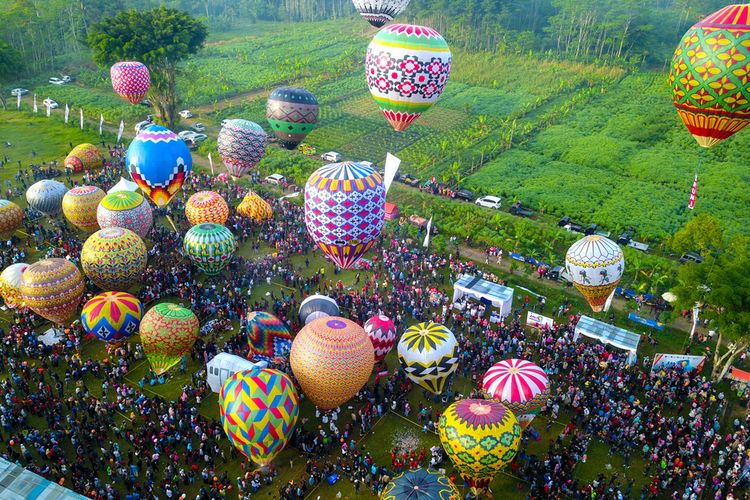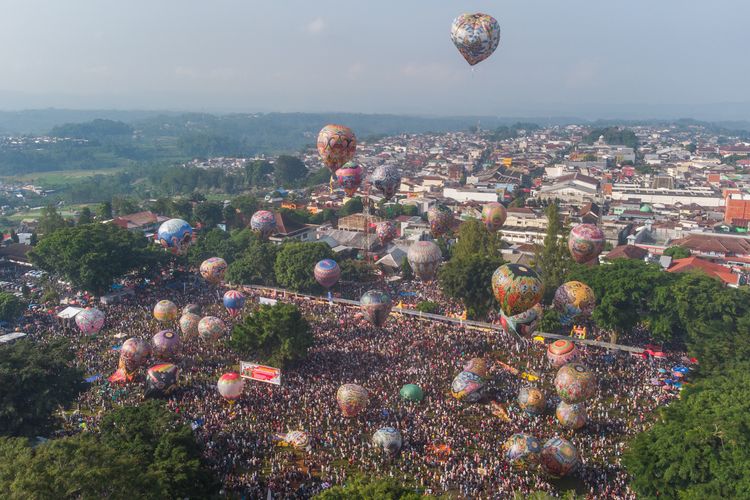JJS Jateng Gayeng, WONOSOBO - Wonosobo is synonymous with the hot air balloon festival. Apparently, this festival has been a tradition since the Dutch colonial era. When most people hear about hot air balloons, they will immediately mention Cappadocia, Türkiye. Instead of following Cappadocia, hot air ballooning in Wonosobo Regency has actually existed and been a tradition since the Dutch colonial era.
Quoting from the book Traces of the Wonosobo Balloon Tradition, the elders in Wonosobo have carried out the tradition of flying hot air balloons to celebrate Eid since the Dutch colonial era. In the 1920s, the first hot air balloon was invented by a barber, bird cage and lantern craftsman, as well as a tambourine music artist from Kertek District named Atmojo Goper.
Mr Atmojo's hot air balloon was inspired by the landing of a hot air balloon used by photographers for aerial photography in Wonosobo Square at that time. This is also why several areas in Wonosobo had aerial photography at the beginning of the 20th century.
Not as modern as now, Mr. Atmojo's hot air balloons are still very simple, using crepe paper as the basic material. At that time, crepe paper was an expensive material and to get it he needed to order it all the way from Semarang City. The first flight of Mr Atmojo's hot air balloon was carried out in the courtyard of the Krakal Tamanan prayer room and was witnessed by many local residents. Since then, information regarding hot air balloons has spread rapidly and has become a momentum that local residents have always looked forward to.
Before using firewood, at the beginning of its flight the hot air balloon uses a smoking technique which comes from a mixture of dry and wet rice stalks to create thick black smoke. In the 80s, the fuel for smoking began to switch to firewood, until in the 2000s they started using coconut shells, which have clearer smoke and make hot air balloons look more beautiful when flying.
Made from expensive materials, hot air balloons cannot be flown at any time. In the 1960s, balloons made from plastic were created which were used by local people and craftsmen to carry out weather tests before making hot air balloon flights.
It wasn't until the 1990s that hot air balloons made from oil paper were created. Apart from having more attractive patterns and colors, oil paper is also considered easier to fly because it is lighter and easier to find on the market.
Hot air balloon flights, which at that time were just simple post-Eid entertainment, were finally transformed into a major festival event which is regularly held every Wonosobo Regency Anniversary.
In 2005, the first large-scale Traditional Balloon Festival was held at Wonosobo Square. A year later, this festival managed to win 2 student records at once, namely, the record for the most traditional hot air balloons and the record for the largest hot air balloon at that time.
However, this festival journey did not run smoothly. In 2015, the Traditional Balloon Festival which was planned to be held at Kalianget Stadium had to fail because it was considered to be disrupting flights. Until finally several rules were agreed, including limits on the distance that hot air balloons could fly and balloon flights that had to be tethered to the ground (not released into the sky) so that this regular festival could be held again in 2017.
This year, the Wonosobo Balloon Community was officially established. Since then, hot air balloon flights in Wonosobo have become increasingly well known to a wider audience and have even attracted many investors. One of the big festivals that was held was the Java Balloon Festival in 2019.
Until now, hot air balloon craftsmen are increasingly mushrooming in Wonosobo. The quality and shapes of the balloons also vary and are getting better. Festivals that originally only received at least 7 balloons now each festival can fly dozens or even dozens of hot air balloons with increasingly unique packaging. Various balloon flying teams usually also bring dancers and musical accompaniment to enliven the festival.
Every time Eid al-Fitr arrives, various villages in Wonosobo independently hold a Hot Air Balloon Festival. The Wonosobo Hot Air Balloon Community recorded that around 1,500 hot air balloons were flown during Eid 2017. This euphoria was stopped due to the Covid-19 pandemic that hit Indonesia. This festival is a strategic step for the Wonosobo Regency Government in attracting many tourists from various regions to see the natural beauty and traditions of the area which is nicknamed the land of the clouds.




Comments